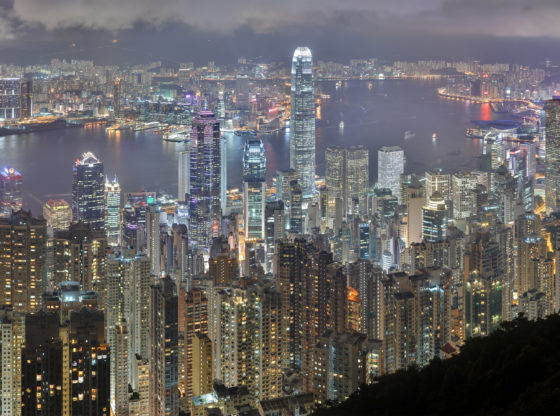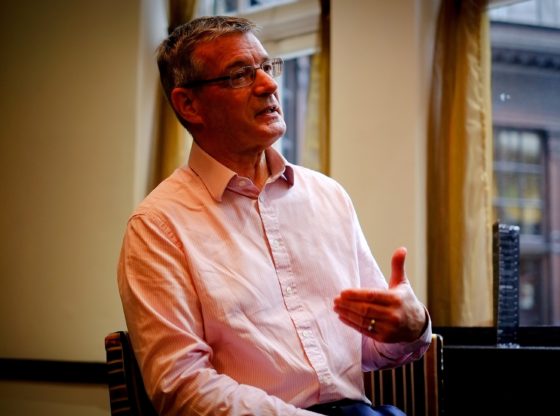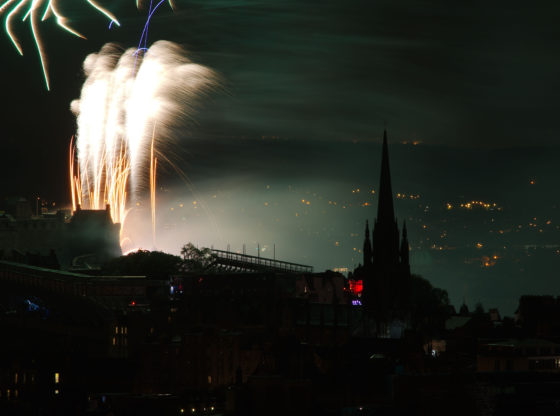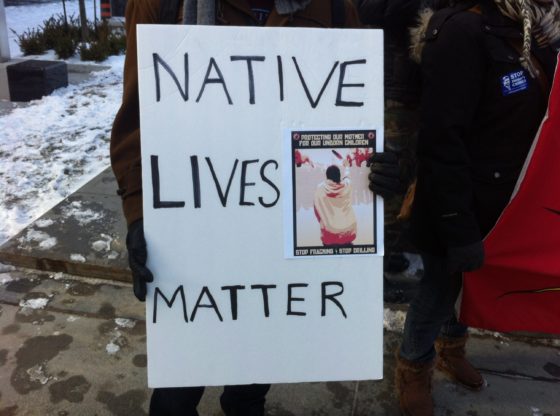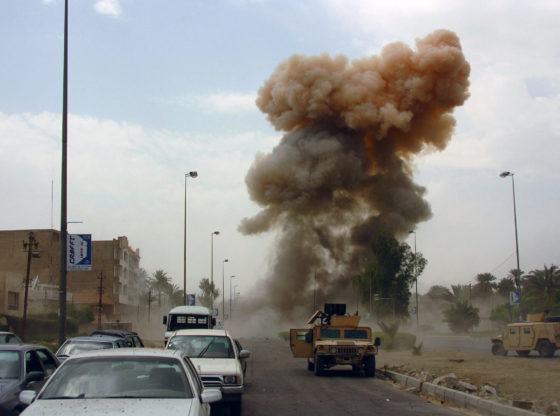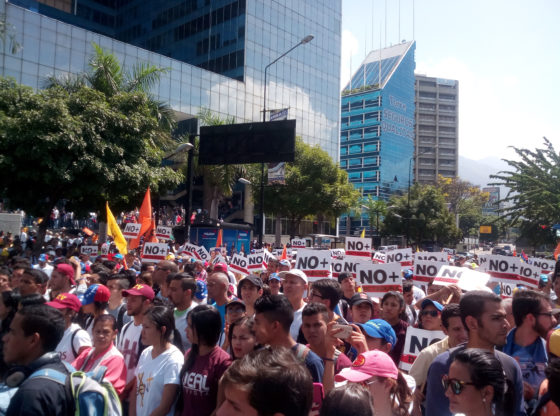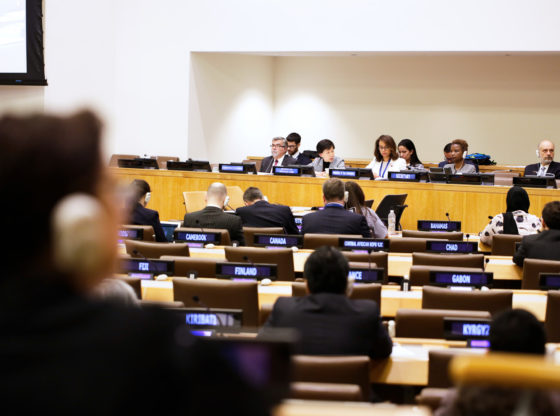Julie McDowall’s Cold War in Concrete series, written exclusively for CABLE, will profile some of Scotland’s Cold War sites. In the first article of the series, Julie visits the Skelmorlie nuclear bunker. She paints a vivid picture of the bunker’s physical characteristics but also what it must have been like to occupy and operate the facility in the event of a nuclear attack.
There’s something lying in the middle of the field. It looks like a huge green Lego block.
The cows ignore us as we walk through the grass towards it. Frank takes out a bunch of keys. He slides one into the top of the block, twists it, and pulls opens a metal trapdoor. Inside is a vertical shaft, going deep underground. A steel ladder is pinned to the wall.
“I’ll go first,” says Frank.
There’s a knack to climbing into one of these tiny nuclear bunkers but I quickly forgot it. MIND YOUR HEAD AND BACK said a yellow sign. I forgot that too. My only concern was not to slip off the ladder and crash to the bottom but I needn’t have worried. The shaft is so narrow that if you lean slightly, the grubby white walls nudge you back onto the ladder.
With baby steps and clammy hands I gradually reached the foot, and looked back up to a square of pale sky. Outside were green fields with a view down to the glittery Firth of Clyde. And Largs was out there, with its candy floss and coconut ice cream, its ten pin bowling and fish suppers for a fiver. But I was down here in the damp earth in a tiny nuclear bunker built for three.

This is the Royal Observer Corps 23 Post Skelmorlie, to give the place its proper title. There were 1,563 of similar shelters across Britain, and hundreds in Scotland. They would have sheltered the volunteer men and women of the Royal Observer Corps (ROC) who, upon receiving the dreaded order, would have kissed their families goodbye, grabbed a bag, and headed to their designated bunker. Their duties were to wind the siren, producing the infamous “four minute warning”, and then descend into the bunker to await the nuclear bombs and report vital information on their location, yield and fallout.
Each post would report on local conditions and feed these to their HQ, allowing a picture to emerge of the newly-devastated Britain: which cities were hit, which roads were impassable, which bridges were down, and where fallout was likely to descend. Each area would draw up their piece of the map, forming a ghastly jigsaw of post-nuclear Britain.
The little bunkers were usually sited on high land but could also be found in parks, housing estates and council offices. The ROC was disbanded in 1991 but their posts are still here, though most of them are abandoned, rusted shut, burned out, covered by weeds, or flooded to the brim with rainwater. Some have been snapped up by adventurous folk who’ve turned them into wine cellars or birdwatching dens. Others are used by businesses for storing documents or drugs. You might pass one every day on your way to work, and spot the old door fenced off and padlocked, but dismiss it as something to do with the electricity board maybe, or the council.
At the foot of the ladder is a cupboard containing tools and an Elsan chemical toilet. A sign instructs you to “kiss your arse goodbye” if the Bomb drops.
When people think of the ROC, most will think of the Blitz. They’ll picture a man in a tin hat scanning the sky with binoculars. Maybe he’s called Charlie or Alf. We know him from black and white war films. It’s his finest hour. He clocks the planes. He lifts the phone. The RAF scrambles. The siren sounds. But with the Cold War, the ROC’s Observers came down from the roofs and went underground, ready to track nuclear bombs instead of enemy planes.
Frank Alexander lives in Largs. He served in the ROC at the Skelmorlie post and was lucky enough to rescue his old bunker from ruin and dampness. He restored it to its Cold War state, gathering memorabilia and rescuing ROC instruments from a skip outside the old Scottish Home and Health Department, where they were dumped with giddy relief after the fall of the Soviet Union. He calls it his retirement project, and I was lucky enough to get the grand tour.
At the foot of the ladder is a cupboard containing tools and an Elsan chemical toilet. A sign instructs you to “kiss your arse goodbye” if the Bomb drops. In training sessions, where Observers might be confined to their bunkers for 24 hours, everyone tried to avoid using the Elsan as the thing had to be hauled up the shaft to be emptied and it would be sloshing with strong blue chemicals and other unmentionables. The men could pop outside when nature called, but female Observers were often forced to use it, and to save any blushes from visiting a bathroom in such close quarters, some gallant male Observers would sing loudly when their female colleague had to use the Elsan.
Next to the toilet is a larger room containing a set of narrow bunk beds and a desk where the various instruments are laid out for monitoring the nuclear explosions and fallout. There are maps on the walls, and shelves holding training manuals, a First Aid kit, and ration packs containing things like “Baconburgers”, “Processed Cheese” and “Chocolate Sweets Type A”. And that’s it: the workspace, the toilet, and that hatch clanging shut above you, blocking out the soft square of sky.
There was a small grey box in each post called the Carrier Receiver which quietly ticked. This constant ticking was a sign that that all was well, but if the ticking suddenly stopped and broke out into a wailing noise, followed by the verbal message “Attack Warning Red”, it meant a nuclear attack was incoming and the ROC had to jump into action.
Frank explains you were allowed to furnish the post to make it more homely. Some brought dartboards, playing cards, and scraps of carpet. Frank even managed to manoeuvre an armchair down the shaft. Home comforts when training for nuclear war.
But what were they training for? There was a small grey box in each post called the Carrier Receiver which quietly ticked. This constant ticking was a sign that that all was well, but if the ticking suddenly stopped and broke out into a wailing noise, followed by the verbal message “Attack Warning Red”, it meant a nuclear attack was incoming and the ROC had to jump into action.
Britain had sirens on many public buildings, like police stations and town halls. They could also be found on the roofs of factories, schools and hospitals. These would be triggered by the police on receipt of the “Attack Warning Red” signal, but many rural communities would be out of earshot so their nearest ROC posts were given hand-operated sirens. These were also distributed, along with a subtle Carrier Receiver, to the homes of ‘respectable’ local folk in the countryside, such as doctors, teachers or pub landlords, who’d volunteered to sound the alarm. In this way, much of Scotland’s rural population would be within earshot of a siren.
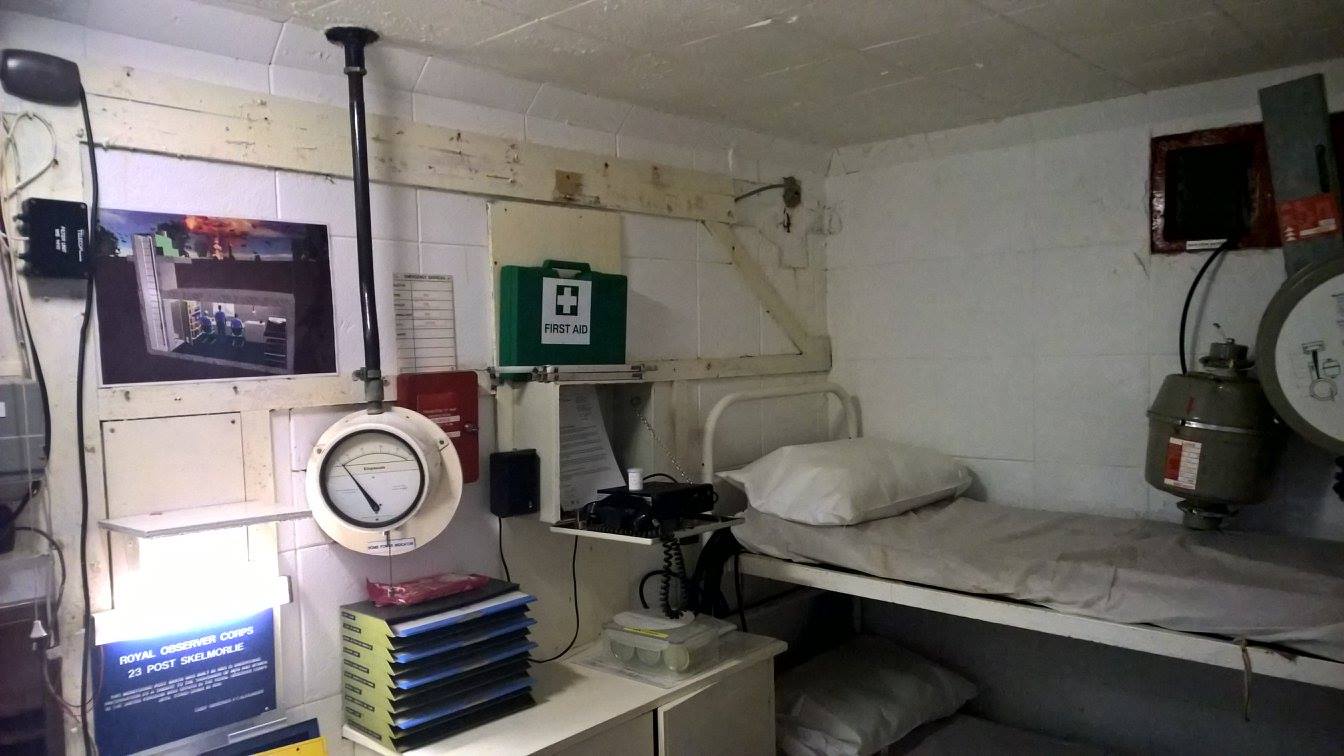
The ROC’s sirens, resembling a metal barrel on a tripod, would be hauled out of the shaft on a rope. On receiving the signal it’d be cranked by hand – five fast turns and then five slow to produce the distinctive wailing sound – then it’d be laid flat on the ground and the Observer would retreat down the ladder and lock the hatch.
With all three Observers safely secured in the post, there’d be nothing to do but wait for the bombs to drop. It might seem like an odd question but how do you know when a nuclear bomb has detonated? If you’re not close enough to feel the blast or heat, and if you’re underground and so cannot see the flash, then it won’t be immediately obvious. Some larger nuclear bunkers were equipped with AWDREY machines (Atomic Weapons Detection Recognition and Estimation of Yield.) These looked like big grey fridges covered in buttons, levers and lights and their purpose was to detect a nuclear explosion and give an estimate as to its size. Yes, you might need a machine to confirm Armageddon. But the tiny bunkers of the ROC could barely squeeze in Frank’s comfy armchair, let alone a huge, clunking AWDREY. Instead, they had the Bomb Power Indicator (BPI). This was a white dial like a huge clock face which sat at the desk. It was connected to the world above by a pipe and measured the change in air pressure when a blast wave swept over the ground. It was a kind of hellish barometer. So when its needle jerked into life, nuclear war had begun. Observers would note the power of the bomb and report it to HQ, using the code word “Tocsin Bang”. This allowed the staff in Control to confirm the general location and sizes of the nuclear bombs falling on Britain.
But Control needed more precise details. Where exactly did it explode and was it an air burst which creates more blast damage, or a ground burst which creates more fallout? This information would come from the dreadfully unlucky person who’d been nominated as “No 3 Observer” - he had to go outside.
Beside the hatch was the Ground Zero Indicator (GZI), a basic pinhole camera. It was a white, cylindrical drum (white to deflect heat, and cylindrical to allow the blast to pass over) which contained photographic paper. The flash from the bomb would burn through the tiny hole and scorch the paper, and the size and position of the scorch mark would provide more precise information on the explosion. Poor old No 3 had to go up there and retrieve it, getting the first glimpse of post-nuclear Britain.
Writing in the New Statesman in 1981, the investigative journalist Duncan Campbell noted that Square Leg envisaged “the worst devastation in all of Britain” on Glasgow and the Clyde.
There would be no shortage of work for the hundreds of ROC posts in Scotland. Aside from the plentiful military targets - including the Granddaddy of them all, Faslane - Scotland had various civilian and industrial locations which would have been likely targets. The UK government’s “Square Leg” exercise in 1980, which practised a response to a Soviet nuclear attack, saw Scotland suffer terribly. Writing in the New Statesman in 1981, the investigative journalist Duncan Campbell noted that Square Leg envisaged “the worst devastation in all of Britain” on Glasgow and the Clyde. Faslane and our numerous airbases would be hit, as would all Scottish industrial cities, plus Dounreay, the Grangemouth refinery, and the nearby Kincardine Bridge.
The wreck of Scotland’s infrastructure would have given the ROC a secondary role. After the war, and once radiation levels had reduced, the Observers would be expected to climb out of the bunker - if they were able - and explore the area to report on whether roads were passable and bridges still standing. Frank explained he would have checked out the pier at Wemyss Bay to see if it could still be used for shipping. This mobile monitoring would, in theory, allow authorities to evacuate people from fallout areas, and move medical supplies and food around the country.
It’s easy to feel hopeless when contemplating such destruction, and only a fool would imagine a nuclear war to be “winnable”. But there’s no doubt the ROC’s work would have guided some survivors away from the path of fallout, and helped authorities plot escape and supply routes. Whether it would have been worth the effort is another matter.
Julie McDowall is a freelance journalist, writing about books, TV, and the Cold War. She is currently writing a book on how Britain prepared for nuclear war. You can find her on Twitter @JulieAMcDowall or online at www.juliemcdowall.com
Feature image: View of the Skelmorlie bunker. ©Julie McDowall. All rights reserved.


